By Dave DeWitt
Note: This is a glossary of the most common ingredients in world curries. I have eliminated some of the more common foods that are curried, such as meats, seafood, fruits, and vegetables, and have concentrated on herbs, spices, seasonings, flavorings, and unusual condiments.
 |
Ajowan (Carum copticum). Called “Bishop’s weed” in some parts of Africa, it is a hairy herb with pungent seeds; an occasional spice in some African curry mixes. |
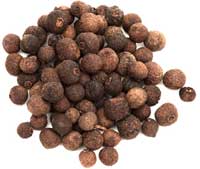 |
Allspice (Pimenta dioica). The dried fruits of a tropical tree, grown mainly in Jamaica, which suggest the aroma of cinnamon, nutmeg, and cloves. An ingredient in West Indies curries and some commercial curry powders. |
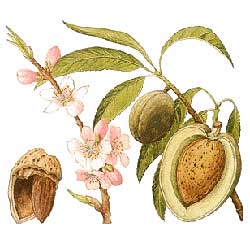 |
Almonds (Prunus amygdalis). The familiar cultivated nut; an occasional ingredient in curries around the world. |
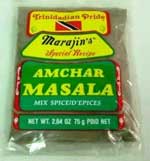 |
Amchar. In India, mango powder; in the West Indies, a masala used to curry mangoes. |
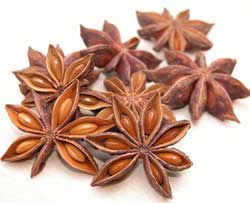 |
Anise (Pimpinella anisum). The licorice-flavored seeds of an annual herb. An occasional ingredient in Indian curry powders. |
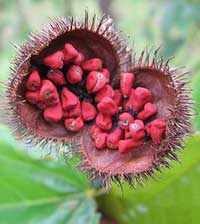 |
Annatto (Bixa orellana). An orange-colored extract of the seeds of the annatto tree. Also called achiote, it used as a coloring agent and seasoning. An ingredient in some commercial curry pastes. |
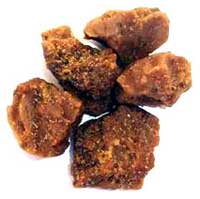 |
Asafoetida (Ferula asafoetida). A gum-resin from the giant fennel plant, used as a seasoning in home and commercial Asian curry pastes. |
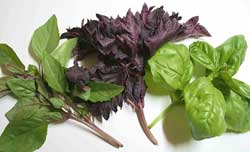 |
Basil (Ocimum basilicum). A common herb native to Central Asia. Fresh basil is an ingredient in curries from the Malaysian state of Selangor and in curried butters in Ethiopia. |
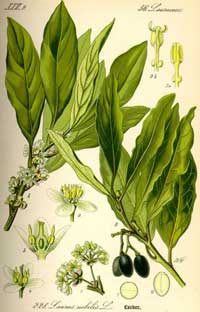 |
Bay Leaf (Laurus nobilis). The leaf of the sweet bay, or laurel tree. An ingredient in Indian and South African curries and some commercial curry powders. |
 |
Black Pepper (Piper nigrum). The pungent berry that is perhaps the most famous spice in the world. It is ubiquitous in curry blends all over the world. |
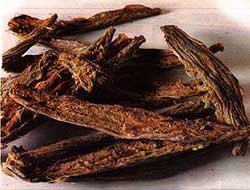 |
Bombay Duck. This ingredient is not duck at all, but rather a small, salted, dried fish that accompanies curries in India and is a curry ingredient in Malaysia. Substitute anchovies. |
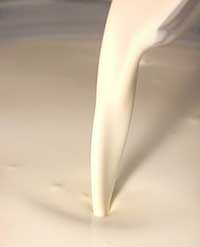 |
Buttermilk. A thinner version of yogurt; remove the butter from yogurt, and you have buttermilk. Buttermilk is used in curries in southern India. It is also made into a refreshing summer drink, with green chiles, black pepper and salt thrown in it. |
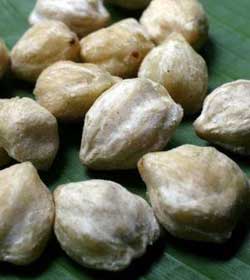 |
Candlenut (Aleurites moluccana). A fleshy nut of the candleberry tree of Southeast Asia, used as a thickening agent in curries. Substitute macadamia nuts, Brazil nuts, almonds, or cashews. |
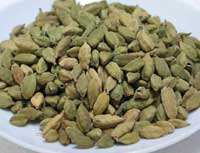 |
Cardamom (Elettaria cardamomum). The seeds of a relative of ginger, primarily grown in India and Guatemala. Unripe (green or white) cardamom pods are also sold; the seeds must be removed before using. A common ingredient in home and commercial curry powders. |
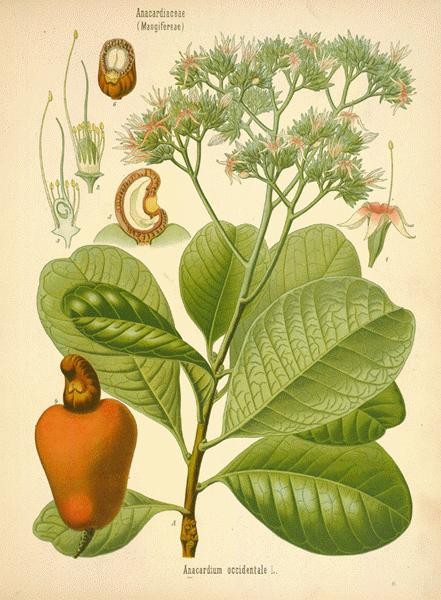 |
Cashew Nut (Anacardium occidentale). Nut of a small evergreen tree (cashew apple) of the Western Hemisphere that is laden with fat, up to 48 percent. They are commonly used in south Indian curries and snacks. They are an occasional ingredient in Nepalese and Spice Islands curries. |
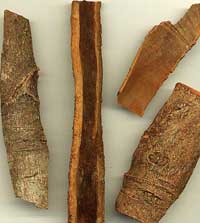 |
Cassia (Cinnamomom cassia). The scraped, dried bark of a relative of cinnamon. It is often used in place of cinnamon in the curries of Southeast Asia and Malaysia. |
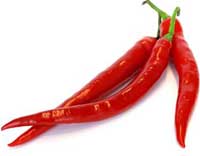 |
Cayenne (Capsicum annuum). One of the hotter dried chiles; its powder commonly appears in worldwide curries. See Chile peppers. |
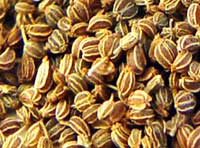 |
Celery seed (Apium graveolens var. dulce). The seed of the common salad vegetable. An ingredient in some commercial curry powders. |
 |
Chile Peppers (Capsicum spp.). The fruits of the Capiscum genus, they provide most of the heat in curries. They are found all over the world and are used dried in commercial home powders and both fresh and dried in curry pastes. I have suggested appropriate chiles and substitutions in the recipes. |
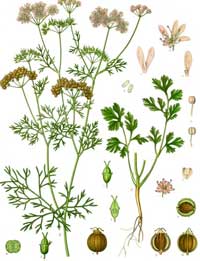 |
Cilantro (Eryngium foetidum). Coriander leaf, often used as a garnish for curries, or is chopped and sprinkled over them. An ingredient in some curry pastes. |
 |
Cinnamon (Cinnamomum zeylanicum). The bark of an evergreen tree which grows in western India and in Sri Lanka. It is a common ingredient in curry powders and pastes from all over the world. |
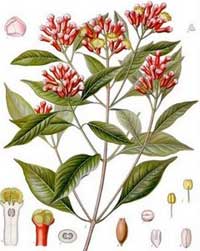 |
Cloves (Eugenia caryophyllata). The dried, unopened flower buds of an evergreen tree native to the Moluccas; the spice is now grown extensively in Zanzibar. Cloves are a common ingredient in curry powders and in curry pastes from Southeast Asia, Malaysia, and Indonesia. |
 |
Coconut (Cocos nucifera). The fruit of the Cocos genus of palms, found in tropical regions all over the world. The grated flesh, and milk extracted from it, appear in tropical curries from around the world. |
 |
Congo pepper (Capsicum chinense). A extremely hot chile that is commonly added to Trinidadian curries. |
 |
Coriander (Eryngium foetidum). The seed of a Mediterranean herb; one of the commonest ingredients in curry powders. |
 |
Cumin (Cuminum cyminum). The seed of a common annual herb native to Egypt; another common ingredient in curry powders. |
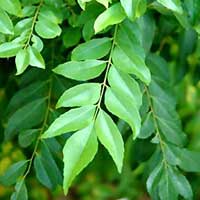 |
Curry leaf (Murraya koenigii). The aromatic leaf of the curry leaf tree, which grows on the Indian subcontinent. The leaf is used primarily in Indian home curry powders, and usually does not appear in commericial powders and pastes. |
 |
Dill (Anethum graveolens). The seed of a biennial herb native to southern Europe; an ingredient in some commercial curry powders. |
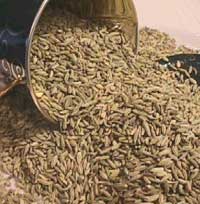 |
Fennel (Foeniculum vulgare). The seed of a perennial herb native to southern Europe; an ingredient in some commercial curry powders. |
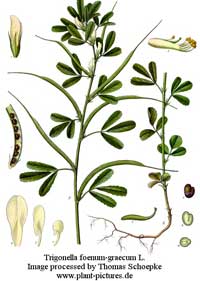 |
Fenugreek (Trigonella foenumgraecum). The seeds of an annual herb native to the Mediterranean area and India. A common ingredient in Indian curry powders. |
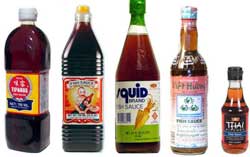 |
Fish Sauce. Called nam pla in Thailand and nuoc cham in Vietnam, this salty, fermented fish sauce is found in Southeast Asian curries. |
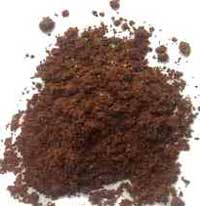 |
Five-Spice Powder. A blend of star anise, fagara (Chinese prickly ash), cassia, fennel, and cloves; popular in Southeast Asia, it occasionally appears in curries. |
 |
Galangal (Alpinia galanga). A close relative of ginger, this rhizome appears in curry pastes from Southeast Asia, Malaysia, and Indonesia. |
 |
Garlic (Allium sativum). A perennial herb which appears in curries and curry pastes all over the world. |
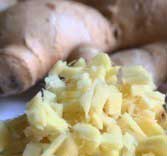 |
Ginger (Zingiber officiale). A rhizome that appears in curries, curry powders, and pastes all over the world. |
 |
Gram. Certain plants of the pea family, especially chickpea. Gram flour is known as besan. Gram most commonly appears in Indian curries. Green gram, known as moong, can be found in Asian markets. |
 |
Jackfruit. (Artocarpus herterophyllus). A tropical fruit, its seeds and flesh are cooked, pickled and roasted. In southern India, jackfruit curries are popular in the summer months when the fruit is abundantly available. The jackfruit flesh is also ground with rice and turned into fritters. |
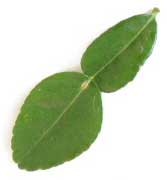 |
Kaffir lime leaves (Citrus hystrix). Leaves of a Southeast Asian citrus tree; used in curries and curry pastes of the region. |
 |
Lemongrass (Cymbopogon citratus). The bulbs and lower stalk of this perennial plant have a strong citrus flavor. It is used in Southeast Asian, Malaysian, and Indonesian curries and curry pastes. If fresh lemongrass is used, cooks should remove the upper two-thirds of the stalks and cut the rest, including the bulb, into small bits. In the case of dried lemon grass, it should be soaked in warm water for 90 minutes before use, drained, and chopped. |
 |
Mace (Myristica fragrans). The outer, fibrous covering of the nutmeg seed; occasionally appears in curry powders. |
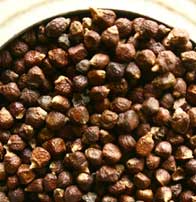 |
Malagueta pepper (Afromomum malagueta). Also called “grains of paradise,” and “false cardamom,” these seeds of a ginger relative appear in African curry powders. |
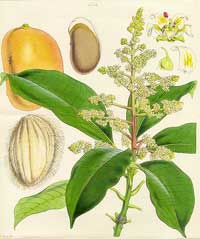 |
Mango (Mangifera indica). A tropical fruit that is used both as a dessert and key ingredient in the curries of southern India and the West Indies. |
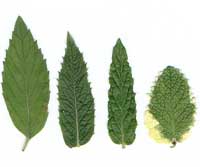 |
Mint (Mentha arvensis). A common perennial herb and an ingredient in some Singaporean curries, North African spice blends such as harissa. |
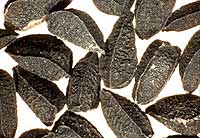 |
Nigella (Nigella sativa). Also called black cumin, this plant is native to North Africa. Its black seeds have a lemon-carrot aroma, and they are used in some North African curry powders. |
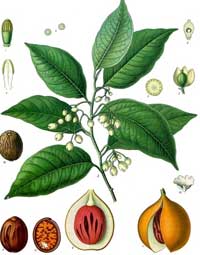 |
Nutmeg (Myristica fragrans). The seed of an evergreen tree native to the Moluccas; a common ingredient in world curry powders and pastes. |
 |
Okra (Hibiscus esculentus). The pods of an annual vegetable; an occasional ingredient in Malaysian curries, often used as a thickening agent. It is widely used in curries and soups (sambhar) in southern India. |
 |
Onion (Allium cepa). A common ingredient in curry pastes and dishes around the world. It appears in some commercial curry pastes. |
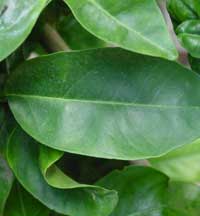 |
Orange leaf (Citrus aurantium). From the common orange tree; an ingredient in South African curries. |
 |
Orris Root (Iris germanica). The dried root of the German iris, which has a violet-like aroma. An ingredient in some North African spice mixtures. |
 |
Papaya (Carica papaya). A widely used tropical fruit. Green papayas are widely used in curries in India; the ripe papayas are used as desserts. |
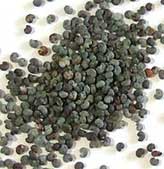 |
Poppy seed (Papaver somniferum). The seed of the opium poppy; an ingredient in North African curry pastes and some Nepalese curries. |
 |
Prawn Paste. Called blacan in Malay, this strongly smelling paste is made with fermented prawns and salt. The fishy odor dissipates during cooking. It is sold in blocks and cakes in Asian markets. Substitute Shrimp Paste, or Fish Paste as a last resort. Called hei-ko in Chinese and petis in Malay, shrimp paste combines shrimp and salt, which are allowed to ferment. It is milder than Prawn Paste and is an ingredient in some commercial Thai curry pastes. |
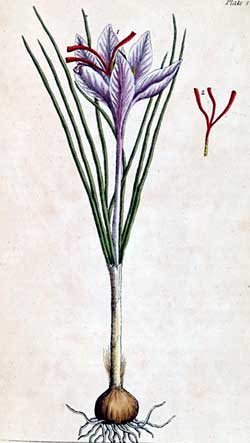 |
Saffron (Crocus sativa). The dried stigmas of a variety of crocus flower, used in Moghlai curries. It is regarded as the most expensive spice in the world. It is available whole, powdered, or in liquid essence form. |
 |
Salam (Eugeneia polyanza). A laurel leaf which dries to a very dark color, almost black; used in Malaysian curries. It is not a bay leaf, but bay leaves may be substituted. |
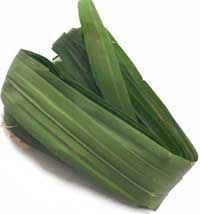 |
Screwpine (Pandanus odoratissimus). Leaves that are used to flavor rice in India and Malaysia. Available in leaf form or essence in some Asian markets. |
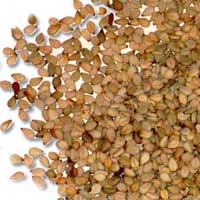 |
Sesame seeds (Sesamum indicum). The seed of an annual herb indigenous to Indonesia; an occasional ingredient in Indonesian and Malaysian curries. |
 |
Shallots (Allium ascalonicum). This onion-like bulb is an ingredient in Malaysian, Thai and Singaporean curries and curry pastes. |
 |
Tamarind (Tamarindus indica). The five-inch pods of this tree contain seeds and a sour pulp. The pulp and seeds can be rehydrated in hot water and then strained. Tamarind can also be found in specialty markets in a variety of forms: pastes, concentrates of pulp, and whole pods dried into bricks or ground into powders. |
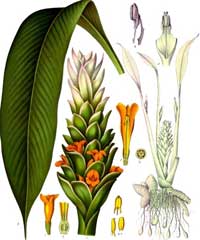 |
Turmeric (Curcuma longa). The yellow rhizome of a relative of ginger; one of the most common ingredients in world curries, curry powder, and curry pastes. |
 |
Yogurt. Fermented and coagulated milk; an occasional ingredient in South African curries but used more frequently in Indian curries. |





